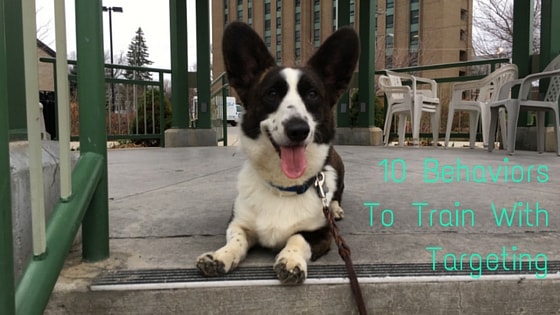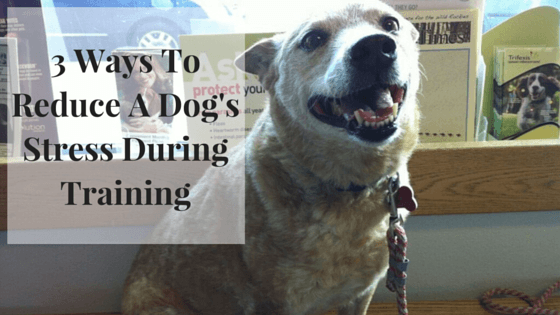![10 Behaviors To Train With Targeting]()
by Monica Callahan | Jan 5, 2015 | Training Methods

10 Behaviors You Can Teach With Targeting
One of the first behaviors we recommend teaching every client a nose target. There are many behaviors you can teach with a nose target, and even more you can teach with general targeting. We also believe it is a good behavior to teach in the beginning because it can help clients sharpen their clicker mechanics. Clients are able to physically feel the behavior they are supposed to click. Here are 10 good behaviors you can train with basic targeting.
1. Loose Leash Walking
Once the dog is able to nose target your hand well, it can be a big help for teaching loose leash walking. Instead of luring the dog with food, you can place your hand exactly where you want the dog to be (lined up with your leg), and click/treat them when they target your hand. If the dog is very target savvy, they can follow your hand for multiple steps before you click/treat. You can eventually fade out the hand target and have a very nice loose leash behavior. This can also help with heeling.
2. Mat Work
Mat work is very popular. It can provide a dog their own space whether in the house or in a foreign location. It can also be a helpful tool when trying to teach impulse control or relaxation methods. Instead of using just a nose target, mat work is a whole body targeting technique. You are teaching the dog that when they see their mat, they are to place their entire body on top of the mat. You can decide if you want only a down, or if you will accept a sit or stand on the mat. This can be applied to their cage, or a certain spot in the house when doing a certain activity. For example, when I’m cooking in the kitchen, you are to stay on the kitchen rug out of my way.
3. Platform Work
Platforms are very useful for many different dog sports or training techniques. You can use a platform as a ‘home base’ if you are working with multiple dogs. You are training the dog to target their whole body to a platform and to stay until you call them off. Another form of platform work is to teach the dog to target their two front paws on a platform and to pivot. This helps the dog learn hind end awareness which is very helpful for many dog sports including obedience, rally, agility, and freestyle.
4. Close The Door
A fun behavior to teach with targeting is closing the door. Using a nose target, you can train the dog to close the door through small approximations. If the dog can nose target a sticky note, have the dog target the sticky note on an open door and click for any movement of the door when they target the note. Once the dog knows what you are asking for and can close the door, you can begin to get rid of the sticky note by making it smaller and smaller until you no longer need the sticky note. People love seeing this behavior and will love to show off this skill to their friends. You can also work this with dresser drawers.
5. Recall/Come
Many people do not think of a recall as a targeting behavior, but it definitely can be. If you ask for the target cue from further and further, you are essentially asking the dog to recall from further and further away. You can eventually switch to a recall cue if you want to use something else, or you can just continue using your target cue.
6. Basic Obedience Cues
Your basic obedience cues such as sit, down, and stand can be taught with targeting instead of luring. Once the dog has the hang of a nose target, instead of using a piece of food to lure their nose up for a sit, you can just have the dog target your hand up into a sit. The same can happen for a down or a stand behavior. Some people prefer targeting over luring for these behaviors before you do not have to fade out the treat lure. It can be easier to fade out your hand movement or simply create a hand signal for the behavior.
7. Leg Weave
You can teach the dog to weave between your legs very easily with a nose target. Have the dog sit and stay and make a triangular space with your legs large enough for the dog to go underneath. Ask for a nose target on the opposite side of your legs and click as the dog targets your hand and moves between your legs. Once they catch on, you can ask for multiples weaves before rewarding. A very impressive, but easily taught behavior.
8. Saying “Hi!”
If the dog is an excited greeter, you can use a hand target for greeting in order to keep the dog from getting over excited. Having the dog on leash when guests come over gives the dog time to calm down before greeting the guests. Once they have calmed down a bit, the guest can ask for a hand target and then the dog can reorient to you for reinforcement.
9. Medical Behaviors
Targeting can be used to help a dog become comfortable with handling or procedures at the vet’s office. Targeting behaviors are used with large animals in aquariums and zoos to help veterinarians get samples or perform procedures on them. A prolonged target behavior can make it easier to give vaccines, take samples of blood, or get a physical exam. If the dog is doing a job, they will be more focused on the job than on what is occurring. A highly reinforced behavior like targeting can also help to calm the dog during a stressful situation. These targeting behaviors can even be done muzzled if you need that extra protection for veterinarians and staff.
10. Take A Bow
This cute finisher can easily be taught with a nose target. It is very similar to a down, but your precise clicker mechanics will come into play here. As the dog is going down to target your hand between their legs, you click as the behavior is happening, but before they drop their rear into a down. Too many bad clicks in down position will confuse the dog and will get you a down instead of a bow. Once the dog is getting pretty good, you can begin to fade the hand target and you will end up with a nice finishing behavior for all your future demonstrations.
Targeting is a very fun behavior for dogs and quickly becomes very highly reinforcing for them. These are ten behaviors you can teach with targeting, but the possibilities are truly endless when it comes to behaviors you can teach with targeting. What behaviors do you teach your clients with targeting? Do you prefer fun tricks or behavior modification with targeting?
Get Dog Training Business Tips!
Receive valuable dog training business tips and resources every month! Subscribe to The Modern Dog Trainer now by submitting your name and email below.
[mc4wp_form]
![10 Behaviors To Train With Targeting]()
by Monica Callahan | Dec 3, 2014 | Training Methods

Reducing Stress In Dog Training
The very nature of training can be stressful to a dog. Not all stress is bad. However, when a dog has many different stress-inducing factors piled on top of each other, this can become overwhelming and cause the dog to act out or shut down. When a dog is too stressed out, learning does not occur. For this very reason, we must try to minimize the amounts of environmental stress our dogs experience during training. Here are three ways you can reduce stress in dog training.
1. Clean Clicker Mechanics
If a teacher were asking you questions in class and then having to look up every answer you gave them to make sure they were right, you’d become incredibly frustrated after a while. The same thing can happen with our dogs. If our marker words or clicks are too slow, our treat delivery sloppy, or our attention is not completely on our training session, the dog is likely to get frustrated and may stop trying. Making sure your mechanics are clean and on time will do a lot for a dog’s confidence and stress level. It’s also our job, as the trainer, to make sure our client’s mechanics are clean. Playing some clicker mechanic games before introducing your client’s newly acquired training skills to their dog can go a long way for the stress level of their dog. You can find more about clicker mechanics here.
2. Appropriate Distraction Levels
When a dog is worked in an area where there are too many distractions for their level of training, they can become incredibly stressed for a few different reasons. If the dog is prone to being anxious, too many distractions can cause them to go through information overload and they can become stressed out. When a dog is stressed, they cannot provide their owners with the attention their owners want. When the owners see their dog’s attention elsewhere, the owner can become stressed with the training process. Feeding off the owner, the dog becomes even more stressed. It is a stressful cycle to get in. To make both the dog and owner successful, lowering the distractions around the session to a level the dog can be successful is key.
3. Small Steps
When we are working with clients and their dogs, we are generally helping them build behaviors for their dogs. We have to take small steps towards the big picture goal. When we expect dogs to take leaps in training, they can become lost and get stressed when they don’t know what we are asking for. Training will go quicker when we ask for smaller steps that they can build on quickly. Taking larger steps may slow us down as the dog has to guess and interpret what we are asking for.
Some level of frustration will always be present in training, however, we should always do our best to make sure the least amount of frustration is present when training. Showing our clients how to use a clicker and how to build behaviors appropriately is our duty as a trainer. When our dogs are happy, we will get cleaner, quicker, and better behaviors.
What other ways can we lower our dog’s stress during a training session?
Get Dog Training Business Tips!
Receive valuable dog training business tips and resources every week! Subscribe to The Modern Dog Trainer now by submitting your name and email below.
[mc4wp_form]
![10 Behaviors To Train With Targeting]()
by Monica Callahan | Dec 1, 2014 | Training Methods

How To Prevent Bribery In Dog Training
In the dog training world, there seems to be two big groups of clients. On one side, there are clients who are incredibly stingy and hoard treats like they are gold, and on the other side, there are clients who never let a treat leave their hand or in front of their dog’s noses. For those clients who find it hard to put down the treats, we have to get creative and find ways to get those treats out of their hands. Here are some tips on how to prevent bribery in dog training.
Treat Bags
If clients are working away from their ziplock bag of treats, it is likely that they will take handfuls so they don’t have to keep going back to the bag every click. A treat bag on their waist or a treat vest will keep their treats accessible so they do not have to load up a handful before a training session.
Let Me Help You
As a teacher, we are there to monitor our students. If we hold the treats for our clients, then we can monitor when they go for the treats. This can make our clients more aware of their clicker and treats, and prevent them from grabbing a treat before they click. This technique does require you to accompany the client as they work so their treats are accessible. An approach like this may not be appropriate for everyone or every dog. Assess your situation before utilizing this approach.
Positions
If your client consistently grabs for a treat before the click, try finding a ‘home’ station. Collaborate with your client and find a position that their hands can go back to every time after clicking and treating. Once they use the position enough, it will become second nature and will get rid of the premature grabbing of the treats. This technique can also be used with the previous suggestion.
TAG Teaching
TAG teaching is the human equivalent of clicker training. You, the trainer, will come up with a TAG point for your client. A TAG point is the criteria of what you want. An example could be, “The TAG point is hand on thigh.” It would be your client’s job to return their hand to their thigh after every click/treat. When your client does place their hand on their thigh, you would click your own unique clicker just for your client. In this case, the click is reinforcement to your client for a job well done. TAG teaching makes your client aware of what is expected of them and makes them more aware of what they are doing. After enough times, it becomes routine for your clients to keep placing their hand on their thigh. To learn more about TAG teaching, visit their website here.
Being a trainer means that we must be good teachers to our clients. When our clients have good clicker mechanics, they can achieve anything they want. Sometimes we have to use our creativity to help our clients become proficient at training.
What other creative ways have you used to get treats out of your client’s hands?
Get Dog Training Business Tips!
Receive valuable dog training business tips and resources every week! Subscribe to The Modern Dog Trainer now by submitting your name and email below.
[mc4wp_form]
![10 Behaviors To Train With Targeting]()
by Monica Callahan | Nov 15, 2014 | Communication
Involve The Whole Family In Training
When working with a family and their dog, the children are always excited to help mom and dad train their dog. Parents often push the kids to the side and get frustrated when they keep interrupting. Instead of continually being interrupted, you can incorporate the children in the training. Here are three ways to incorporate your client’s children in training.

1. Recall Games
Children love high energy games, whether they are running or the dogs are. Recall games are a great way to incorporate the client’s children because it can get the dog running and wear them out. Have the children stand across the living room and practice calling the dog’s name once and treat when the dog arrives. They’ll think it’s amazing when the dog listens. Eventually they can play hide and seek and have the dog find them throughout the house. This is also a great bonding game for the dog and children and turns their children into rewards for the dog.
2. Treat Deliverer
This idea would be geared toward the better listener in the family. An example would be working on crate training. If mom or dad has the clicker, just let the child know that whenever they hear a click, they are to give a treat to the dog. When the dog enters the crate and mom or dad click, the child can then deliver a treat to the dog or drop it in the crate.
3. Distraction Training
Children are a big distraction to dogs, and their movements can also be highly alarming to them. You can use their quick movements to proof their dog’s current behaviors or desensitize a worried dog to the child. In the beginning, have the child move slowly and then work up to quicker movements.
Children love to feel like they are being useful. With some simple tweaks to training, children can certainly be incorporated. Once children reach a certain age and maturity, they could even take over training. Training is a great way to bond with their dog, and a pleasant, respectful relationship between children and their dog is important in a family. The next time you have an interruptive child at your training session, don’t allow the parent to get flustered, suggest they help instead.
What are some other ways you, as a trainer, can incorporate children throughout the training process?
Recommended Articles
![10 Behaviors To Train With Targeting]()
by Monica Callahan | Nov 1, 2014 | Business
Marketing your business can be daunting, but it doesn’t have to be.
Word of mouth is a great way to get more business, but that can take a while to grow. Marketing is the quickest way to build clientele. Most dog trainers lack a background in marketing, and may be intimidated by the process. Here are 3 easy ways to market your new dog training business that you can implement today.

1. Make information packets for local veterinarians, dog walkers, and groomers.
Get in touch with other local animal professionals and start a referral system. Many people ask their vets, groomers, and walkers for a local dog trainer recommendation. Put together folders with tips that dog owners could find valuable, some information on your modern training techniques, and how to get in touch with your business. Don’t forget to include business cards for their lobby!
2. Start a business newsletter or write for a local newspaper.
Keeping your clients up to date on training information and what you are offering will make them more likely to come back. Start a newsletter that you e-mail to subscribers and past clients to keep them in the loop. Writing for a local newspaper or magazine will get your name out there and showcase your knowledge, which will make you more appealing to potential clients.
3. Get a table at your local event.
Many communities have local events that vendors can buy a space or even attend for free. Set up a table with some information of your business and training techniques and a small give-a-way to bring people to your table. Some events you can look for include craft shows, rescue events, and city rec center events.
With a little bit of work, these three marketing techniques can be an easy way to get your name into the community. There are plenty of marketing ideas out there, what are some other easy ways to get your name into the community?
Recommended Articles








